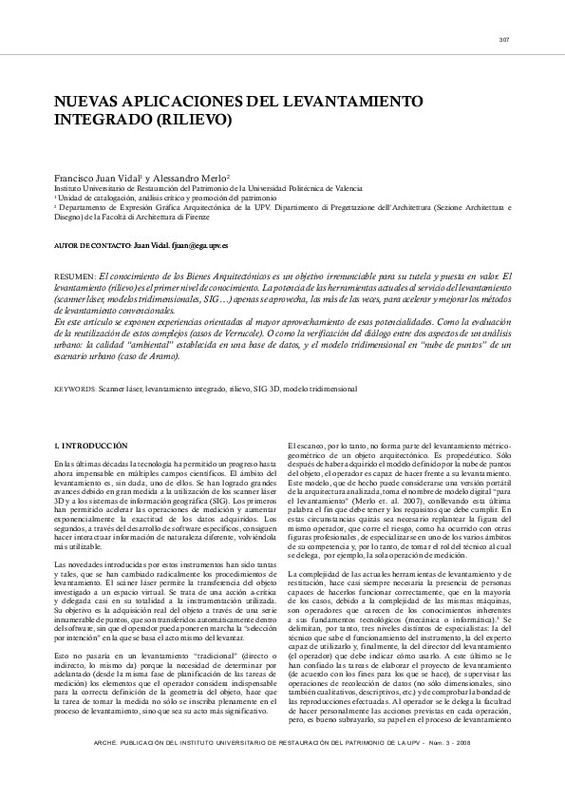JavaScript is disabled for your browser. Some features of this site may not work without it.
Buscar en RiuNet
Listar
Mi cuenta
Estadísticas
Ayuda RiuNet
Admin. UPV
Nuevas aplicaciones del levantamiento integrado (rilievo)
Mostrar el registro sencillo del ítem
Ficheros en el ítem
| dc.contributor.author | Juan Vidal, Francisco
|
es_ES |
| dc.contributor.author | Merlo, Alessandro
|
es_ES |
| dc.date.accessioned | 2013-09-09T07:14:48Z | |
| dc.date.available | 2013-09-09T07:14:48Z | |
| dc.date.issued | 2008 | |
| dc.identifier.issn | 1887-3960 | |
| dc.identifier.uri | http://hdl.handle.net/10251/31876 | |
| dc.description.abstract | Knowledge of the Architectural Heritage is essential for its protection and valuation. The elevation (rilievo) is the first step to understanding the concept . The power of the actual tools that serve the elevation (scanner laser, three dimensional models, SIG...) is hardly made use of, but when is needed, is used to accelerate and improve the methods of the conventional elevation. This article deals with experiences orientated to the major use of this potential power. Such is the case with the evaluation of the re-use of these complexities (the cases of Verrucole). Or the case with the verification of the dialogue between the two aspects of an urban analysis: the "environmental" quality established in a data base and the three dimensional model in "points in the clouds" of an urban setting (the case of Aramo). | es_ES |
| dc.description.abstract | El conocimiento de los Bienes Arquitectónicos es un objetivo irrenunciable para su tutela y puesta en valor. El levantamiento (rilievo) es el primer nivel de conocimiento. La potencia de las herramientas actuales al servicio del levantamiento (scanner láser, modelos tridimensionales, SIG...) apenas se aprovecha, las más de las veces, para acelerar y mejorar los métodos de levantamiento convencionales. En este artículo se exponen experiencias orientadas al mayor aprovechamiento de esas potencialidades. Como la evaluación de la reutilización de estos complejos (casos de Verrucole). O como la verificación del diálogo entre dos aspectos de un análisis urbano: la calidad "ambiental" establecida en una base de datos, y el modelo tridimensional en "nube de puntos" de un escenario urbano (caso de Aramo). | es_ES |
| dc.format.extent | 10 | es_ES |
| dc.language | Español | es_ES |
| dc.publisher | Instituto Universitario de Restauración del Patrimonio de la UPV | es_ES |
| dc.relation.ispartof | Arché | es_ES |
| dc.rights | Reserva de todos los derechos | es_ES |
| dc.subject | Scanner láser | es_ES |
| dc.subject | Levantamiento integrado | es_ES |
| dc.subject | Rilievo | es_ES |
| dc.subject | SIG 3D | es_ES |
| dc.subject | Modelo tridimensional | es_ES |
| dc.subject | Integrated elevation | es_ES |
| dc.subject | Relief | es_ES |
| dc.subject | Three-dimensional model | es_ES |
| dc.subject.classification | CONSERVACION Y RESTAURACION DE BIENES CULTURALES (UPV) | es_ES |
| dc.title | Nuevas aplicaciones del levantamiento integrado (rilievo) | es_ES |
| dc.title.alternative | New Applications of Integrated Elevation | es_ES |
| dc.type | Artículo | es_ES |
| dc.rights.accessRights | Abierto | es_ES |
| dc.contributor.affiliation | Universitat Politècnica de València. Instituto Universitario de Restauración del Patrimonio - Institut Universitari de Restauració del Patrimoni | es_ES |
| dc.description.bibliographicCitation | Juan Vidal, F.; Merlo, A. (2008). Nuevas aplicaciones del levantamiento integrado (rilievo). Arché. (3):307-316. http://hdl.handle.net/10251/31876 | es_ES |
| dc.description.upvformatpinicio | 307 | es_ES |
| dc.description.upvformatpfin | 316 | es_ES |
| dc.description.issue | 3 | |
| dc.identifier.eissn | 2445-1150 |
Este ítem aparece en la(s) siguiente(s) colección(ones)
-
Arché - Nº 03 : 2008 [45]






